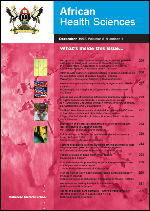
|
African Health Sciences
Makerere University Medical School
ISSN: 1680-6905
EISSN: 1680-6905
Vol. 18, No. 2, 2018, pp. 281-286
|
 Bioline Code: hs18037
Bioline Code: hs18037
Full paper language: English
Document type: Study
Document available free of charge
|
|
|
African Health Sciences, Vol. 18, No. 2, 2018, pp. 281-286
| en |
Histo-pathological pattern of intracranial tumours in the National Hospital, Abuja
Jibrin, Paul; Ibebuike, Kaunda & Ado-wanka, Aisha Nabila
Abstract
Background/aims: Intracranial tumours demonstrate characteristic diagnostic histopathological features. Our aims were to
look at the histo-pathological pattern of intracranial tumours in our environment including their age and sex distribution.
Methods: The histology request forms and slides of all intracranial specimens submitted to the histo-pathology department of
National Hospital, Abuja, over an 11 year period (2005 and 2015) were retrospectively reviewed.
Results: Intracranial specimens and intracranial tumours accounted for 0.6% and 0.5% respectively of all samples submitted.
Meningiomas accounted for the most frequent diagnosis for all intracranial specimens and intracranial tumours at 35% and 41%
respectively followed by pituitary adenoma at 19% and 22%, and astrocytoma at 13% and 20%. The male female ratio for all
diagnoses was 1:1. The mean age at diagnosis was 35 ± 17.1 years. The frequency of intracranial tumours in children was 11.8%
with a mean age of 8.3 ± 4.4 years and an equal sex distribution. In children, glioma and embryonal tumours were the most
frequent diagnosis at 25%.
Conclusion: The histo-pathological pattern of intracranial tumours in our environment showed that meningioma is the most
common intracranial tumour in adults, while glioma and embryonal tumours are the most common intracranial tumours in
children.
Keywords
Histo-pathological pattern; intracranial tumour; meningioma; glioma; embryonal tumours.
|
| |
© Copyright 2018 - Jibrin et al.
|
|
